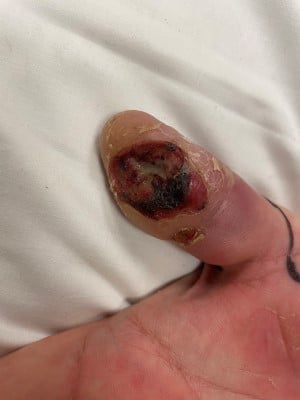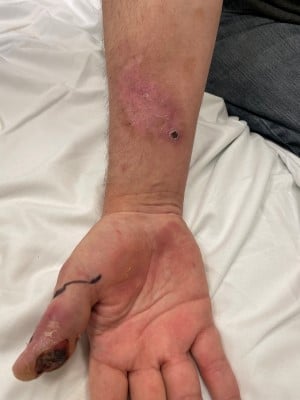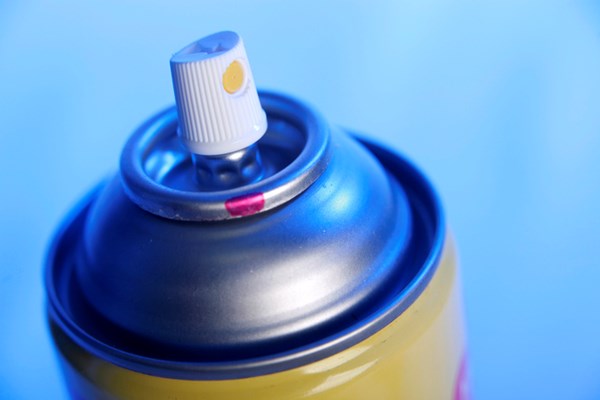The use of inhalants can lead to classic findings in the emergency department, but don’t forget to perform a thorough skin exam in any patient experiencing the effects of huffing.
Case
A 54-year-old male presented to the emergency department with a chief complaint of hallucinations and recent use of inhalants.
He reported a history of intermittent inhalant use over the past 15 years, primarily using electronic duster cans. He reported inhaling 10-15 cans daily over the past week, after a period of abstinence. The patient stated that over the past few days, he had been hearing voices commanding him to remove his firearm out of his safe. The patient also reported that he had been seeing moving shadows and people in his home that he believed were trying to rob him. On the morning of presentation to the ED, the patient removed his firearm from the safe without remembering, and expressed fear that he might accidentally harm a family member with his firearm.
Initial vital signs in the ED included BP 125/84, HR 87, T 36.7 C, RR 20, SpO2 97% on room air. On examination, the patient appeared tremulous with pressured speech but was oriented to person, place, time, and event. Skin exam was notable for a chronic appearing wound present on the right thumb (Image 1) with tissue loss and probe-to-bone noted. The right forearm also demonstrated signs of thermal injury (Image 2). On further questioning, the patient could not report the duration of his thumb or arm injuries.
Cardiovascular, respiratory, and abdominal exams were otherwise unremarkable. Labs were notable for a white blood cell count of 12,200/uL, ESR 43 mm/h, and CRP 62.6 mg/L. Comprehensive metabolic panel and venous blood gas were normal. EKG showed normal sinus rhythm and normal intervals. Radiographs of the hand demonstrated small cortical erosion at the volar thumb distal phalanx, consistent with chronic osteomyelitis.

Image 1. Chemical burn resulting from inhalant use

Image 2. Chemical burn resulting from inhalant use
Discussion
Inhalant use, otherwise known as huffing, sniffing, bagging, or dusting, typically involves the inhalation of volatile or aerosolized hydrocarbon-based products leading to a euphoric effect or otherwise altered mental state. More commonly used inhalants include chlorofluorocarbons (eg, difluoroethane, tetrafluoroethane) found in computer keyboard spray or “duster,” aromatic hydrocarbons (eg, toluene, xylene) found in adhesives and paint thinners, aliphatic hydrocarbons (eg, butane, gasoline) found in petroleum distillates, or nitrites (eg, “poppers”), commonly sold as club drugs. Additionally, non hydrocarbon inhalants such as nitrous oxide (whippets) also have been used as inhalants. The pharmacologic effects and clinical presentations can vary significantly from one substance to another.1,2 Further, there is little literature characterizing the pharmacologic properties of inhalants, as many are not marketed for human consumption and otherwise do not serve a medical or therapeutic purpose.
Inhalant use is more common in younger individuals, with most reported users aged 25 and younger. Inhalant use is also more prevalent in lower socioeconomic classes and rural settings, which is likely due to the relative ease of access and inexpensive nature of most inhalants.2
Inhalants have high lipophilicity, leading to most striking CNS effects. Initial CNS effects include euphoria and hallucinations, both auditory and visual hallucinations. Toxicity can lead to CNS depression, slurred speech, confusion, tremor, weakness. Ataxia, lethargy, seizures, coma, respiratory depression can occur as well.2
Psychiatric effects from inhalants may include disorientation, agitation, psychosis, or psychomotor slowing. In the absence of laboratory abnormalities, treatment is largely supportive, and benzodiazepines are recommended.2 Ongoing psychiatric disturbances may require consultation with Psychiatry and potential hospitalization. Patients may experience withdrawal from long-term inhalant use, which often mirrors alcohol or benzodiazepine withdrawal symptoms including tachycardia, tremors, diaphoresis, vomiting, and seizures.1 Medical and behavioral management may be required to treat inhalant use disorder, which is a distinct diagnosis according to DSM-5.3
Complications of inhalant misuse include hypoxic brain injury and sudden death from hypoxia, which may occur in as little as a single ingestion. White matter degeneration can occur after chronic use.1,4 Any inhalant can potentially cause “sudden sniffing death” via myocardial sensitization, often seen after increased physical activity (eg, running away from parents or authorities after being caught using inhalants). The mechanism behind myocardial sensitization is thought to be due to the blocking of potassium current, leading to prolonged repolarization. This produces potential for dysrhythmia propagation during increased activity or stress that leads to catecholamine surge. More commonly, cardiotoxicity present with palpitations, shortness of breath, syncope, and ECG abnormalities including atrial fibrillation, premature ventricular contractions, QT prolongation, and U waves.2
The most significant respiratory complication is hypoxia, which is either caused by displacement of inspired oxygen with inhalant, reducing FiO2, or by rebreathing exhaled air with bagging.2
Chemical pneumonitis is seen frequently with aliphatic hydrocarbons due to their toxic effect on pulmonary tissues with aspiration.5 Intraoral thermal/chemical injuries in these patients can also lead to airway compromise.6 Inhalant use is also associated with apnea, methemoglobinemia, renal tubular acidosis, hepatotoxicity, and acute myelocytic leukemia.1,4,7 Appropriate resuscitative measures should be considered in ill-appearing patients, including a low threshold for intubation. Continuous cardiac monitoring, monitoring of pulse oximetry, and serial echocardiograms may also be necessary.
Dermatologic findings associated with inhalant use include cold thermal injuries, or “frostbite” secondary to holding a can while huffing, or perioral dermatitis secondary to irritant properties of the inhaled substances (“glue sniffer’s rash”).8 Patients may also show larger rashes after prolonged exposure to cans or accidental discharge of contents onto the skin while altered.9
In addition to appropriate resuscitative measures, it is important to perform a thorough skin examination in patients suspected of inhalant use; consider consultation with burn surgery or orthopedics as necessary. In the patient described above, chronic inhalant use and repeated thermal injury to the thumb from the spray can is suspected to have led to gradual tissue destruction to the bone.
Case Conclusion
The patient was admitted voluntarily to the mental health unit for psychiatric stabilization and treatment of substance use disorder with an orthopedic consult. The orthopedic management of the patient’s osteomyelitis during his hospitalization included ceftriaxone IV in the ED and oral amoxicillin-clavulanic acid, as admission to the inpatient mental health unit precluded ongoing IV drug administration.
References
- Radparvar S. The Clinical Assessment and Treatment of Inhalant Abuse. Perm J. 2023;27(2):99-109.
- Long H. Chapter 81. In: Goldfrank’s Toxicologic Emergencies, Vol. 11. Mcgraw-Hill Education;2019:1193-1202.
- Inhalant Use Disorder. In: Diagnostic and Statistical Manual of Mental Disorders, 5th ed. American Psychiatric Association;2013: 533-538.
- Romero J, Abboud R, Elkattawy S, et al. Troponemia Secondary to Air Duster Inhalant Abuse. Eur J Case Rep Intern Med. 2022;26(9):003556.
- Gummin MR. Chapter 105. In: Goldfrank’s Toxicologic Emergencies, Vol. 11. Mcgraw-Hill Education;2019: 1409-1420.
- Kurbat RS, Pollack CV Jr. Facial injury and airway threat from inhalant abuse: a case report. J Emerg Med. 1998;16(2):167-169.
- Barry K, McAteer KE. Syncope and Methemoglobinemia Preceded by Amyl Nitrite 'Popper' Inhalation. R I Med J. 2013;106(3):49-51.
- Kahn SA, Bierman TV, Larson KJ, Blache AL. Killing Brain Cells and Skin Cells Simultaneously with Inhalant Abuse: Pearls from the National Burn Repository. J Burn Care Res. 2019;40(3):347-348.
- Hawash A, Travers JB, Gokce S. Toxic cutaneous responses from inhalant abuse. JAAD Case Rep. 2018;5(1):31-33.



